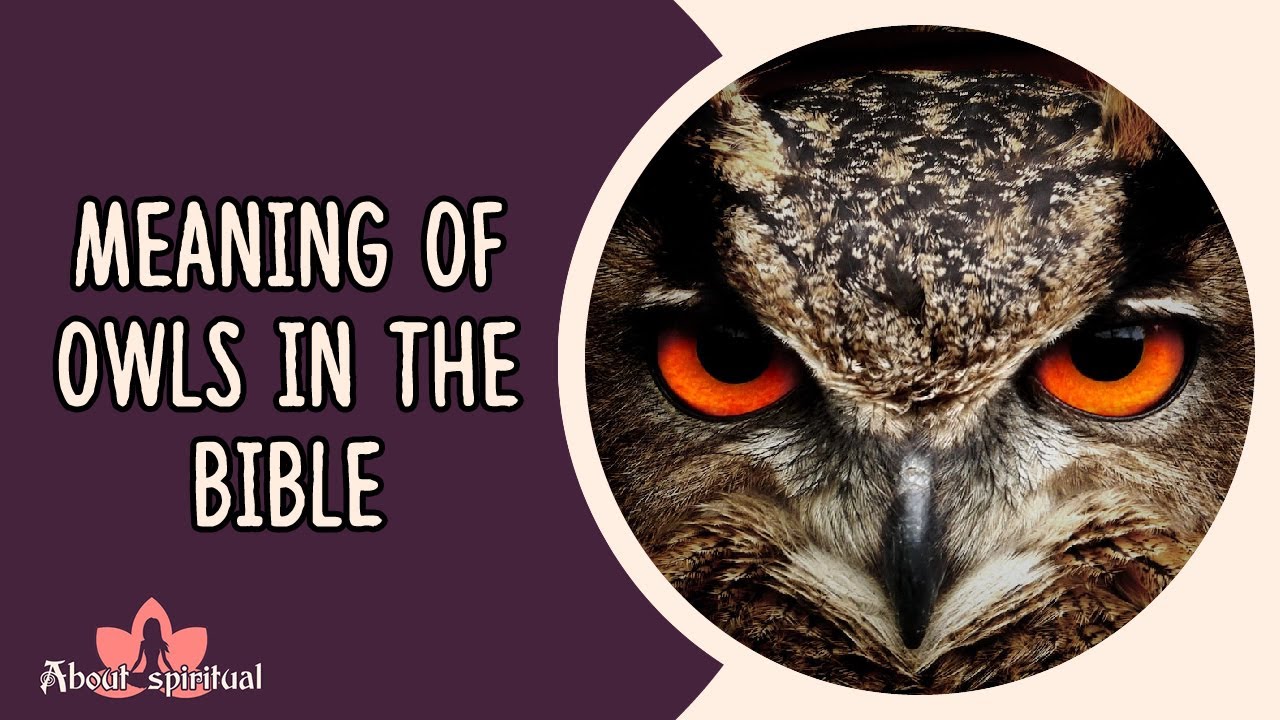O W L Meaning - What Do Owls Represent And Symbolize?
O W L meaning has fascinated people for centuries, with their distinctive features and mysterious behavior. These nocturnal birds of prey have been associated with different meanings and symbolism throughout history and across different cultures. In this article, we will explore the owl meaning and what owls represent in various contexts.
Author:Georgia AshcroftReviewer:Ava MartinezMay 26, 202323K Shares320.3K Views

O W L meaninghas fascinated people for centuries, with their distinctive features and mysterious behavior. These nocturnal birds of prey have been associated with different meanings and symbolism throughout history and across different cultures. In this article, we will explore the owl meaning and what owls represent in various contexts.
The Physical Characteristics Of Owls
Before diving into the owl's meaning and symbolism, let's first take a look at the physical characteristics of these fascinating birds.
Owls are known for their large and forward-facing eyes, which give them excellent night vision. They also have sharp talons and beaks that enable them to catch and kill their prey efficiently.
Adaptations For Nocturnal Life
Owls have a unique set of physical characteristics that make them well-suited for life in the darkness of night. For example, they have large eyes that take up a significant portion of their head, allowing them to gather as much light as possible in low-light conditions.
In addition, the placement of their eyes is such that they have a wide field of vision, allowing them to see objects both near and far.
Owls also have a large number of light-sensitive cells in their eyes, called rods, which are more effective in low light conditions than the cone cells that are responsible for color vision. As a result, owls have exceptional night vision and can see in very dim light.
Their ears are also specially adapted for nocturnal life. Owls have asymmetrical ear placement, which allows them to locate the source of a sound with incredible accuracy.
They can hear sounds from up to 10 times the distance that humans can hear and can detect sounds as quiet as a mouse moving through the grass.
Feeding Adaptations
Owls have a unique set of feeding adaptations that allow them to hunt and kill their prey efficiently.
Their talons are specially adapted for gripping prey, with sharp, curved claws that can exert a powerful grip. In addition, their toes are flexible and can move independently of each other, allowing them to grasp onto prey of different sizes and shapes.
Their beaks are also adapted for hunting, with sharp, curved tips that can be used to tear flesh. Owls typically swallow their prey whole, and their digestive systems are adapted to handle the fur, bones, and other indigestible parts of their prey.
They regurgitate pellets made up of these indigestible parts, which can be used to study their diet and feeding habits.
Flight Adaptations
Owls have several adaptations that make them excellent fliers, including their wings and feathers. Their wings are broad and rounded, which gives them lift and maneuverability in flight.
They can fly silently due to the specialized structure of their flight feathers, which have fringes that break up the sound of air passing over them.
Owls also have a specialized wing shape that allows them to fly at low speeds without stalling.
This is important for their hunting behavior, as it allows them to fly slowly and silently while searching for prey. They also have a unique ability to hover in place, which allows them to stay in one spot while hunting or searching for prey.
Physical Variations
While all owls share certain physical characteristics, there are also significant variations between different species.
For example, some species have long ear tufts that are used for communication and displays, while others donot. Some species are small and agile, while others are large and powerful.
In addition, the coloration and markings of owls can vary significantly between species. Some species have bold patterns and bright colors, while others are more subdued and camouflaged.
These physical variations can be important for identifying different species of owls and understanding their behavior and habitat preferences.
Physical Threats
Despite their many adaptations and unique physical characteristics, owls face several physical threats in their natural habitats.
For example, habitat destruction and fragmentation can have a significant impact on owl populations, as can climate change and other environmental factors.
In addition, owls are often preyed upon by larger predators, such as eagles and other raptors. They can also be threatened by human activities, such as collisions with vehicles and hunting.
Seeing An Owl Meaning
In many spiritual traditions, seeing an owl is believed to be a sign of guidance and wisdom.
The owl is often seen as a messenger from the spirit world, bringing important messages and insights to those who are open to receiving them.
For those who believe in the power of animal totems and spirit guides, seeing an owl may be a sign that they should pay attention to their intuition and inner wisdom.
The owl's keen senses and ability to see through darkness may be seen as a symbol of the ability to see beyond the surface level of things and connect with deeper truths and insights.
The Symbolism Of Owls In Dreams
Dreaming of an owl can also carry important symbolic meaning. In some cultures, the owl is seen as a symbol of death or the afterlife, and dreaming of an owl may be seen as a sign of impending change or transformation.
However, in other cultures, the owl is seen as a symbol of wisdom and insight, and dreaming of an owl may be seen as a sign that the dreamer is on the right path toward greater knowledge and understanding.
The context of the dream and the specific details of the owl's appearance may also carry important meaning.
For example, if the owl is perched on a branch or other high vantage point, it may be seen as a symbol of higher knowledge and spiritual insight.
If the owl is depicted in flight, it may be seen as a symbol of the dreamer's own journey toward greater understanding and enlightenment.
The Practical Implications Of Seeing An Owl
Aside from its spiritual and symbolic meaning, seeing an owl can also carry practical implications. Depending on the context in which the owl is seen, it may be a sign of danger or a call to action.
For example, if an owl is seen perched on a branch outside a person's window, it may be a sign that the person needs to be more aware of their surroundings and take steps to protect themselves from potential threats.
On the other hand, if an owl is seen in a forest or natural setting, it may simply be a sign of the natural beauty and wonder of the world around us.
The Importance Of Personal Interpretation
Ultimately, the meaning of seeing an owl is highly personal and dependent on the individual's own beliefs, experiences, and intuition.
While there are many common interpretations and symbolic associations surrounding the owl, each person's experience of seeing an owl will be unique and may carry different meanings.
It is important to approach the sighting of an owl with an open mind and a willingness to explore its potential meanings and implications.
By paying attention to our intuition and inner wisdom, we may be able to unlock important insights and guidance from the powerful symbol of the owl.
The O W L Meaning And Symbolism In Different Cultures
The owl's meaning and symbolism have been interpreted differently across different cultures and time periods. Here are some of the most common interpretations of owls and what they represent.
The Owl In Greek Mythology
In Greek mythology, the owl was associated with the goddess Athena, who was known for her wisdom and intelligence.
The owl was considered a sacred bird and a symbol of knowledge, and it was often depicted on coins, pottery, and other objects associated with Athena.
The owl was also thought to be a messenger of death, and its hoot was believed to signal impending doom. Despite its association with death, however, the owl was generally regarded as a positive symbol of wisdom and protection.
The Owl In Native American Culture
In many Native American cultures, the owl was considered a powerful symbol of wisdom and guidance. It was often associated with the spirit world and was believed to possess special powers of insight and intuition.
The owl was also seen as a guardian spirit and protector, and it was often depicted in Native American art and mythology as a guide for those seeking spiritual guidance or direction in life.
The Owl In Hinduism
In Hinduism, the owl was associated with the goddess Lakshmi, who was revered as the goddess of wealth, prosperity, and fortune. The owl was considered a sacred bird and a symbol of good luckand prosperity.
In addition to its association with Lakshmi, the owl was also believed to possess special powers of perception and insight, and it was often depicted in Hindu art and mythology as a symbol of knowledge and wisdom.

Meaning of Owls in the Bible - Symbol of Love or Death?
The Owl In Egyptian Culture
In ancient Egyptian culture, the owl was associated with the goddess Isis, who was revered as the goddess of magicand wisdom.
The owl was considered a symbol of knowledge and intuition, and it was often depicted in Egyptian art and hieroglyphics as a symbol of mystery and magic.
The owl was also believed to possess special powers of protection, and it was often depicted in Egyptian tombs and other burial sites as a guardian spirit for the deceased.
The Owl In Celtic Culture
In Celtic culture, the owl was considered a symbol of mystery and magic. It was often associated with the Celtic goddess Cailleach, who was revered as the goddess of winter and the earth.
The owl was also associated with wisdom and guidance, and it was often depicted in Celtic art and mythology as a guide for those seeking spiritual insight and understanding.
Owl Symbolism In Modern Culture
Owls have also become popular symbols in modern culture, with many people using them in artwork, fashion, and home decor. In recent years, the owl has become a trendy symbol in the fashion industry, with many designers using owl motifs in their clothing and accessories.
The Owl In Popular Culture
In modern culture, the owl continues to be a popular symbol in art, fashion, and media. Its unique physical characteristics and associations with wisdom and mystery have made it a beloved icon in many different contexts.
In art and fashion, the owl has become a popular motif for jewelry, clothing, and home decor. Its image is often used in designs for t-shirts, bags, and other accessories, and its likeness has even been used in high-end fashion designs.
In popular media, the owl has been featured in countless movies, TV shows, and books. From Harry Potter's pet owl Hedwig to the wise owl in Disney's classic film Bambi, the owl has played a variety of roles in popular culture.
Its association with mystery and magic has made it a popular symbol in fantasy and science fiction genres, where it often represents ancient wisdom and power.
The Owl In Environmental Conservation
In addition to its role in popular culture, the owl has also become an important symbol for environmental conservation efforts.
Many species of owl are threatened or endangered due to habitat loss, pollution, and other factors, and conservationists have used the owl as a rallying symbol for their efforts to protect these animals and their habitats.
The spotted owl, for example, has become a focal point for conservation efforts in the Pacific Northwest, where its habitat has been threatened by logging and other activities.
Environmental groups have used the owl as a symbol of the importance of preserving old-growth forests and protecting the biodiversity of these ecosystems.
The Owl In Education And Learning
The owl's association with wisdom and knowledge has also made it a popular symbol in education and learning. Many schools and universities use the owl as their mascot or symbol, representing their commitment to academic excellence and intellectual curiosity.
In addition to its use as a mascot, the owl is also a popular symbol in educational materials, such as textbooks, workbooks, and educational videos. Its image is often used to represent knowledge and learning, and it is a common feature in educational posters and other materials.
The Owl In Spirituality And Self-Discovery
Finally, the owl has also become a popular symbol for those exploring spiritualityand self-discovery.
Its associations with wisdom, intuition, and mystery have made it a powerful symbol for those seeking to connect with their inner selves and explore their spiritual paths.
In many spiritual traditions, the owl is associated with the ability to see through illusions and uncover hidden truths.
Its image is often used in meditation and visualization exercises, where it is used as a guide for those seeking to connect with their inner wisdom and intuition.
People Also Ask
What Does It Mean When An Owl Visits You In Your Dreams?
Dreaming of an owl can symbolize wisdom, insight, and impending change.
How Is The Owl Portrayed In Native American Cultures?
The owl is often seen as a symbol of wisdom, protection, and stealth in many Native American cultures.
Is The Owl A Popular Symbol In Modern Fashion And Design?
Yes, the owl has become a popular symbol in modern fashion and design due to its association with wisdom, mystery, and nocturnal creatures.
What Is The Significance Of The Owl's Large Eyes?
The owl's large eyes represent its keen ability to see through the darkness and perceive hidden truths and insights.
What Is The Owl's Role In Greek Mythology?
In Greek mythology, the owl is associated with the goddess Athena and symbolizes wisdom, strategy, and victory.
Conclusion
The o w l meaning holds significant symbolism in various cultures and traditions worldwide. Whether viewed as a symbol of wisdom, protection, or spiritual guidance, the owl's unique characteristics and behaviors have captivated humans for centuries.
From ancient mythology to modern fashion, the owl's image continues to inspire and fascinate people across the globe. The owl's meaning is a reminder that there is always more to discover and understand in the world around us and that the mysteries of life are waiting to be uncovered.

Georgia Ashcroft
Author
Georgia Ashcroft is a seasoned astrologer and spiritual practitioner with over 5 years of experience. She holds a Master's degree in Physics from Princeton University, enriching her astrological insights with a deep understanding of scientific principles.
Georgia's published works encompass insightful analyses of astrological phenomena, including zodiac signs and horoscope interpretations, establishing her as an esteemed figure in astrological circles.
Beyond astrology, Georgia is passionate about tarot and regularly incorporates its wisdom into her spiritual practice.

Ava Martinez
Reviewer
Ava Martinez is a highly experienced author specializing in spirituality and tarot. With over 12 years of dedicated practice, Ava brings a wealth of experience and expertise to her writings.
She has dedicated herself to helping individuals gain insight and clarity through spiritual practices and tarot consultations.
Her deep connection to spiritual energies and engaging style make her readings a trusted resource for those seeking guidance and enlightenment.
Apart from her literary world, Ava embraces nature's gifts, explores meditation's depths, and intertwines the mystical essence of spells into her holistic perspective on life's journey.
Latest Articles
Popular Articles
